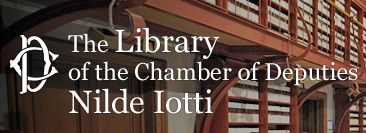The sites and the events
The Chamber of Deputies Library is housed in an area of great historical and artistic significance known as the "Insula dominicana" one of the most important complexes of religious buildings in medieval and modern Rome.
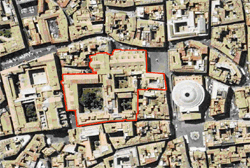
The 'Insula dominicana' complex
Pre-Christian Rome
In ancient Rome, built on one part of the Campus Martius were a number of very important monumental buildings, which included the Iseum et Serapeum, the main shrine of Egyptian cults in Rome, the huge porticoed square behind the Pantheon used for voting, and called Saepta Iulia, and the Temple of Minerva Calcidica, built by Domitian. Numerous major archaeological remains have been unearthed there, such as the statue of Isis, or of her priestess known as Madama Lucrezia, which was used later on by the Romans as a talking statue, the basalt lions which are now kept in the Egyptian Museum in the Vatican and those standing at the sides of the staircase on the Capitoline, transformed into fountains, the mensa isiaca, now in the Egyptian Museum in Turin, and many famous obelisks including those now standing in the centre of the Piazza del Pantheon and on the back of the elephant in Piazza della Minerva, in Villa Celimontana and on the Monument to the Fallen of Dogali, near Piazza dei Cinquecento. The two Hellenistic statues of the Nile and the Tiber, one now in the Louvre and the other in the Vatican Museums, were also found here.
The origins and development of the Dominican complex

Details of the frescoes on the life of Saint Catherine
of Siena in the Cisterna Cloister.
As the great imperial buildings became ruins during the High Middle Ages, a small church was built in the area known as 'St Mary above Minerva' - S. Maria sopra Minerva or S. Maria Sedes Sapientiae -which was occupied by a succession of congregations of nuns. The origins of the Dominican complex as we know it today date back to between 1266 and 1275, when the newly created Dominican Order purchased the pre-existing church and embarked on major development schemes. By around 1280 the Dominicans began building the new Church of S. Maria sopra Minerva, which was essentially completed during the fourteenth century, and a convent built around a large cloister where two conclaves were held, one in 1431 at which Eugene IV was elected and one in 1447, which elected Pope Nicolas V.
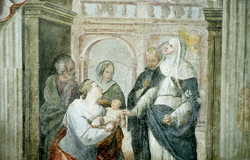
In the fourteenth and fifteenth centuries the Dominican convent at Minerva already played a very major part in Rome's religious life. It was no coincidence that Saint Catherine of Siena (1347-1380) and Fra Angelico (1395-1455) spent the last years of their life there, and are both buried under the church. Because of its heightened importance, in the latter half of the fifteenth century the complex was considerably expanded with a second cloister, the austere Cisterna Cloister under Cardinal Oliviero Carafa (1430-1511), which was recently radically restored, with the dismantling of the bricked-up arches, revealing a cycle of frescoes on the life of Saint Catherine.
The Counter-Reformation
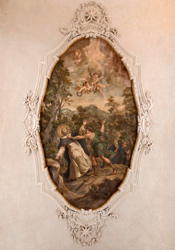
The martyrdom of S. Pietro da Verona:
frescoes in the Sala degli atti accademici
(anon. 18th century)
and in the Sala Galileo
(by Francesco Allegrini)
After a period during which no developments took place, partly due to the crisis that occurred in the wake of the 1527 Sack of Rome, the Minerva complex once again expanded in the latter half of the sixteenth century, when the Dominican Order powerfully relaunched its political and religious work, and a convent became one of the centres in which the Catholic Counter-Reformation was planned. The greatest changes in the complex occurred between 1558 and 1570, when the General Vincenzo Giustiniani (1520-1582) embarked on a radical programme of renewal which ended in the middle of the seventeenth century. The ancient 'great' Cloister (also known as St Catherine's) was completely rebuilt under Guidetto Guidetti, and new buildings were developed around the Cisterna Cloister, and which now form part of the Chamber of Deputies Library: the apartments of the General (aka the 'Inquisition Rooms' Sale dell'Inquisizione), the library (now the Sala delle Capriate), the Refectory (Salone del Refettorio), the Galileo Rooms (Sale Galileo), which, in the course of the 17th-century were decorated with some fine frescoes by Francesco Allegrini celebrating the merits of the Dominican Order in combating heresy.

The name of these rooms is linked to the events surrounding the trial of Galileo Galilei (1564-1642) which ended in the rooms of the Minerva convent. For it was in this building, in one of the rooms subsequently named after him, that Galileo was brought before the Cardinals of the Holy Office and publicly renounced Copernican theory on 22 June 1633. A few years earlier, in 1628, a papal decree designated the convent as one of the premises to be used for the meetings of the Congregation of the Holy Office, that had been instituted in 1542 to coordinate the work of Inquisition.
From the eighteenth century onwards
Between the seventeenth and eighteenth centuries the convent was further extended along what is now Via del Seminario, with the construction of a large garden courtyard. In 1700 the Biblioteca Casanatense library was built under the instructions of Cardinal Girolamo Casanate (1620-1700), when he gave his vast private library to the Dominicans to make it available for public consultation. The centuries-old history of the Minerva complex was brusquely interrupted for the first time with the Napoleonic occupation of Rome, between 1808 and 1814. It was in this period that the convent was used as barracks for Napoleon's troops and suffered serious deterioration as a result. When the temporal power of the papacy was broken (1870) the unitary character of the complex was also broken. The Biblioteca Casanatense became a public State library and the Dominicans moved out to live in a small area behind the church; in 1871 the convent was expropriated to be used to house the Treasury Ministry and later on the Ministry of Education and the Ministry of Posts. The new uses to which the complex was put caused irreversible damage to the structures and the loss of the historical memory of the unitary nature of the complex. It was not until the end of the twentieth century that, with the acquisition of the premises by the Chamber of Deputies, the integrity of the Insula was able to be restored. When the Chamber of Deputies Library was transferred to the premises previously occupied by the Ministry of Posts in 1988 the convent buildings on the side of Via del Seminario were carefully restored, and the original cultural vocation of those ancient places was returned to them. In 2003 the Senate Library (Biblioteca del Senato) was transferred to the Dominican complex in Piazza della Minerva, and in 2007 the institution of the Joint Parliamentary Library (Joint Parliamentary Library ) paved the way for establishing a close linkage between all the facilities installed in the Insula. This has made an extraordinarily important heritage of books and information fully accessible.
See the video on the Chamber of Deputies website
See the Insula sapientiae playlist on Youtube
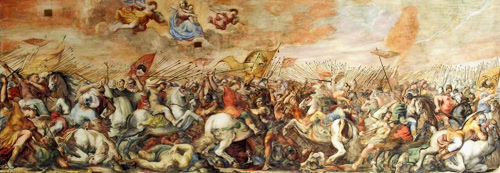
The Battle of Muret, fresco by Francesco Allegrini in the Sala Galileo (History)


